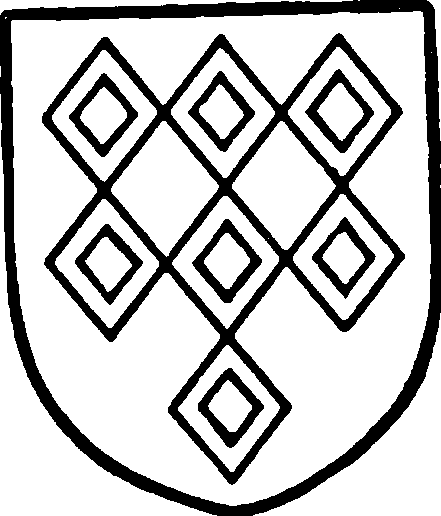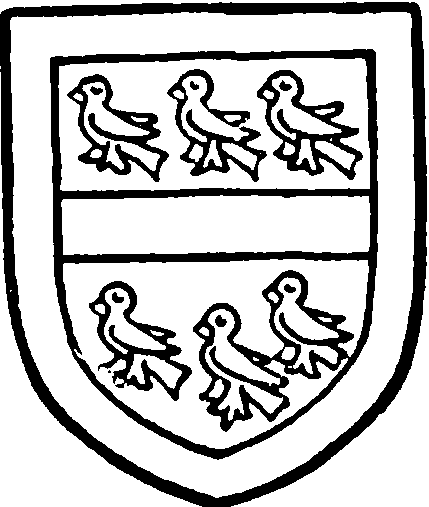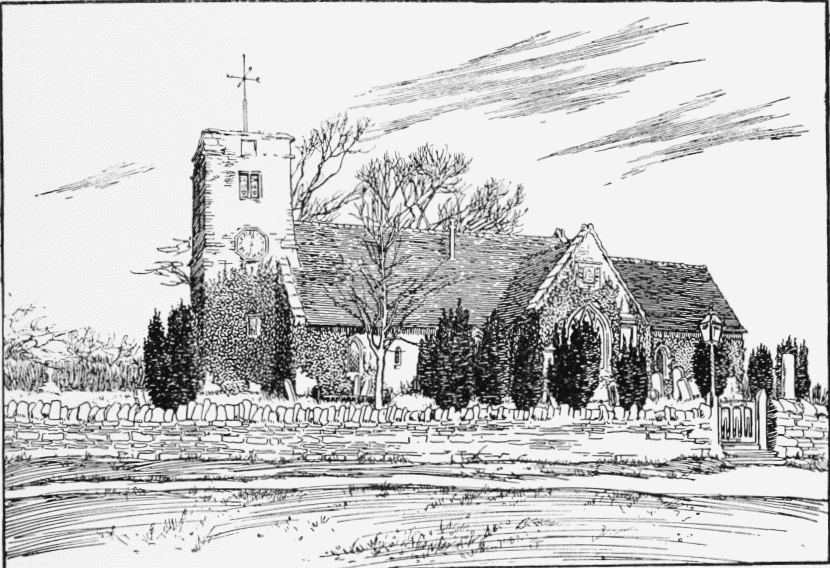A History of the County of Bedford: Volume 3. Originally published by Victoria County History, London, 1912.
This free content was digitised by double rekeying. All rights reserved.
'Parishes: Knotting', in A History of the County of Bedford: Volume 3, (London, 1912) pp. 139-142. British History Online https://www.british-history.ac.uk/vch/beds/vol3/pp139-142 [accessed 24 April 2024]
In this section
KNOTTING
Chenotinga (xi cent.); Cnottinge (xiii cent.); Knottyngges (xiv cent.); Nottinge (xvi cent.); Knottinge (xvii cent.).
Knotting is a small village situated on high ground some 10 miles north of Bedford on the north-western border of the county. Its total acreage is 1,739 acres, of which 846 are arable land and 603 permanent grass. (fn. 1) The soil is black loam and the subsoil clay, the chief crops raised being wheat, barley, beans and peas. The main road from Bedford to Higham Ferrers skirts the two woods known as 'Sheeprack' and 'West Wood.' A point in this road shortly before it crosses the Northamptonshire border has the highest elevation in the parish, being 328 ft. above the ordnance datum. The village lies off this road and is approached by a branch road. In the north stands the parish church on rising ground with a few cottages mostly ancient in character. One of these bears the date 1650, another, belonging to the Ecclesiastical Commissioners, is partly built of the stones of the old parsonage. This latter building is the only part of the parish which does not belong to Mr. Whitbread. The village also contains model cottages built by the Duke of Bedford in the middle of the last century. Knotting Green, an outlying district, lies half a mile to the south of Knotting, and consists of a few modern brick cottages and a Wesleyan chapel. There are several good farm-houses in the parish, including the Manor House, now used as a farm, in the south of the village, and Knotting Green Farm. The parish formerly suffered from insufficiency of water, but in recent years two reservoirs have been constructed at Church End and Knotting Green, and an excellent supply of water is now maintained. (fn. 2)
Grave scandal was caused in the year 1637 by the church being used on Shrove Tuesday for the purpose of cock-fighting. The sport, it is stated, took place 'in the chancel or about the sacred place where the altar stands.' Many persons assembled and there was much wagering, the scandal being all the greater from the presence of the rector and churchwardens. (fn. 3)
A correspondent of Daniel Lysons writing in 1801 stated that from an old map and survey of Knotting it appeared that the parish was much more populous in the 17th century than at that time. The population at the present day is so small that the schools have been closed, and the children of the parish are driven daily to the schools at Souldrop.
There are 200¾ acres of woodland and plantations in the parish, (fn. 4) while 100 years ago there was just double the amount. (fn. 5) In 1176 the whole vill was fined 2 marks for trespass in the king's forest. (fn. 6) That there were red deer in Knotting in the early part of the 17th century is proved by a warrant for their preservation sent by James I to Sir Thomas Tyringham in 1604. (fn. 7)
MANOR
In the reign of Edward the Confessor the property afterwards known as KNOTTING MANOR was held by Burret. (fn. 8) By 1086 it had passed into the possession of the Bishop of Coutances and was assessed at 5 hides worth £4. (fn. 9) The bishop held the manor for life only and on his death it reverted to the Crown, being later granted to the Ferrers family, Earls of Derby, of whom it was held as of their manor of Higham Ferrers (Northants) (q.v.). (fn. 10) The manor continued to be held of Higham Ferrers, (fn. 11) and is referred to as being so held in 1616. (fn. 12)
The first sub-tenants of the manor of whom mention has been found are the family of Bossard. (fn. 13) John Bossard was deforciant in a suit concerning land in Knotting in 1223–4. (fn. 14) He was granted rights of free warren in the manor in 1247. (fn. 15) By 1271 he had been succeeded by his son Hugh, (fn. 16) who five years later successfully claimed rights in Knotting. (fn. 17) The latter was in turn succeeded before 1316 by a son Hugh, who appears to have frequently suffered from financial embarrassment, (fn. 18) and who in 1317 enfeoffed Robert de Tolthorp of the manor to the end that he should be re-enfeoffed in conjunction with Joan his wife. (fn. 19) Hugh Bossard was still holding in 1331, (fn. 20) but by 1346 had been succeeded by Giles Bossard, who held the manor by the service of a third of a knight's fee. (fn. 21) Giles Bossard granted common pasture in the manor to Richard Tessington, clerk, in 1361. (fn. 22) He was the last of the Bossards to hold the manor, and at his death (fn. 23) it appears to have been divided between two co-heirs, one of whom was the wife of Gerard Braybrook, who is recorded as holding the property in 1428, (fn. 24) and who in the same year surrendered his right in the manor to the Dean and Chapter of St. Paul's. (fn. 25) The other was possibly Alice the wife of Richard Brounder, who with her husband quitclaimed her half-share in the manor to the Chapter of St. Paul's for 100 marks of silver in the same year. (fn. 26) Probably the dean and chapter were acting as trustees for Sir Gerard Braybrook's granddaughter and heir Elizabeth Lady St. Amand in her own right, (fn. 27) who is later found holding the manor with her husband Sir William Beauchamp. (fn. 28) Elizabeth's son and heir Richard Beauchamp Lord St. Amand proved a staunch adherent to the house of Lancaster and was attainted in 1483. (fn. 29) The next year Richard III granted Knotting Manor with other property to Thomas Lord Stanley and his son George Lord Lestraunge 'for their good service against the rebels.' (fn. 30) Richard Beauchamp, however, was restored by Henry VII in 1485. (fn. 31) After his death in 1508 (fn. 32) the rightful descent of the manor was not determined without dispute. John Brook Lord Cobham, a cousin of Richard Beauchamp, (fn. 33) is found praying that Thomas, Abbot of the monastery of Stanley in Derbyshire might be forced to give up the title-deeds of Knotting, which had come into his possession, (fn. 34) while his son Thomas Brook a few years later claimed the manors against Anthony St. Amand, natural son of the last lord. (fn. 35) This latter case was submitted to the arbitration of the Archbishop of Canterbury, who gave judgement in favour of Thomas. (fn. 36)

Braybrook. Argent seven voided lozenges gules.

Beauchamp, Lord St. Amand. Gules a fesse between six martlets or with the difference of a border argent.
In 1526 Thomas Lord Cobham granted to one Gregory Cursson and his heirs a lease of the manor for ninety years at a yearly rent of £24. (fn. 37) In order to secure the validity of the arrangement, Lord Cobham placed the manor in the hands of trustees. (fn. 38) After his death in 1529 (fn. 39) his son and heir George ignoring the lease made a forcible entry into the premises and turned Cursson's tenant Elizabeth Hanley and her daughter out of the manor-house. (fn. 40) Cursson appealed to the Star Chamber and the Court upheld him. (fn. 41) Lord Cobham, however, continued his persecution. He induced the tenants on the manor to withhold the rents due to Cursson, and prompted a certain William Hays to enter and take the profits of a part of the manor lands. (fn. 42) In 1554 Lord Cobham alienated the manor to Sir Thomas Pope and Elizabeth his wife. (fn. 43) Sir Thomas died childless in 1559 (fn. 44) and was succeeded by his brother John. (fn. 45) The latter's son William, afterwards Lord Belturbet and Earl of Downe, transferred Knotting Manor in 1599 to Robert Waller, (fn. 46) who, dying seised of it in 1616, was succeeded by his son Edmund the poet. (fn. 47) Knotting cannot be associated very closely with the memory of Edmund Waller, as he seems never to have resided in the parish. Waller held the manor until 1644, when he transferred it to Lawrence Wright. (fn. 48) Sir Henry Wright, bart., the son and heir of Lawrence, held the manor of Knotting (fn. 49) till his death in 1681. (fn. 50) His widow afterwards marrying Edmund Pye, the manor came into the hands of this well-known Berkshire family, who continued to hold it for the next ninety years. (fn. 51) The last member of this family to be lord of Knotting Manor was Henry James Pye, the poet-laureate, who sold the property to the Duke of Bedford in 1774. (fn. 52) The Dukes of Bedford continued to own the manor until 1884, when it was purchased by Mr. Charles Magniac. In 1892 the Knotting property was purchased by Mr. Samuel Whitbread, but the manorial rights did not pass under the sale. (fn. 53)
CHURCH
The church of ST. MARGARET consists of a chancel 25 ft. 9 in. by 16 ft. 2 in., a nave 38 ft. 10 in. by 19 ft. with south porch, a south transept 13 ft. 8 in. by 11 ft. and a west tower 7 ft. 4 in. by 7 ft.
The nave walls date from c. 1140, and are 2 ft. 8 in. thick. The chancel seems to have been rebuilt in the 14th century, and perhaps again later; the south transept is probably a late 13th-century addition, and the tower dates from 1615.
The chancel has a canted plaster ceiling and rough tie-beams with struts, and the lower parts of its walls are panelled in modern woodwork. It has a three-light east window of late date, a square-headed wooden framed north window, on the south a single trefoiled light of 14th-century date, and at the south-east a two-light window with uncusped four-centred heads under a square lintel. The altar rails are 18th-century balusters. The chancel arch is of the date of the nave, round-headed with zigzag ornament on both its orders, and a chamfered label. The outer order has engaged shafts with scalloped capitals, but towards the chancel both arch and jambs are plain.
The nave roof has two rough tie-beams, on the eastern of which is carved a rough leaf ornament, and on the other W.G. 1669, the date of the roof. Such other timbers as are not hidden by plaster are stopped and chamfered, and the struts are curiously shaped. Further west is a third beam at a lower level.
At the north-east is a 17th-century pulpit with a square canopy and a reading desk, and in the north wall a square-headed late 15th-century window of three cinquefoiled lights. Near the west end is a single trefoiled 14th-century light, corresponding to one opposite to it in the south wall, and about midway in the north wall is a blocked square-headed door, the position being probably that of the original north doorway. The south doorway, opposite to it, is plain 16th-century work with a four-centred head, the rear arch having a few stones from the original doorway, and west of it is an original window, a small round-headed light with a wide inner splay. A head has been built in below its sill outside. The arch to the south transept, of two hollow-chamfered orders, springs from good moulded capitals, which do not fit the half-octagonal responds. The transept has a south window of three uncusped lancet lights, in part original, c. 1280, and a small east window of two trefoiled lights of doubtful date. The south porch is of wood, and modern, but the south door is probably of the date of the doorway, a plain piece of woodwork. There are several heavy 17th-century seats at the west of the nave, the westernmost on the north being older, probably early 16th-century work. The tower, built in 1615, according to a date in lead letters on its parapet, opens to the nave by a clumsy round-headed arch, over which is a round-headed 12th-century window, set in a block of masonry 7 ft. wide, projecting from the face of the 12th-century west wall of the nave, and probably originally carried up as a bellcote. The window is framed by a keeled roll, and is not earlier than 1160; it is possible that the whole of the 12th-century work here is of this date. The window is filled with a quatrefoil, probably a 15th-century insertion. The tower is of two stages, the upper of which contains a two-light rectangular window in each face, having in the south window pierced boards with C.L.C.W. 1716. The lower stage of the west front of the tower contains two small rectangular chamfered windows, one above the other, and there is one similar window on the south side and an old one-handed clock; the date 1615 is on the south face of the tower parapet.

Knotting Church from the South
There is a plain octagonal font on a central shaft and four rough rectangular shafts with the exterior angles chamfered off and moulded capitals and bases.
There is one bell by Mears, 1828.
The plate consists of a silver communion cup with an engraved foliated band and a cover paten of 1629, and a modern electro-plated flagon. There is also a pewter plate engraved with an impaled shield of the arms of St. John and the motto 'Data fata secutus.'
The registers previous to 1813 are in three books. Book i has all entries 1592 to 1776; book ii, baptisms and burials 1777 to 1812; book iii, marriages 1754 to 1812.
To the south of the church stands the stump of the churchyard cross.
ADVOWSON
The church of Knotting was originally a chapel to Melchbourne Church (fn. 54); the first mention of it that has been found is in 1176, when the Bishop of Exeter, arbitrating in a dispute between the hospital of St. John of Jerusalem and the convent of St. Neots, gave judgement that the chapel of Knotting should continue to be the property of the Prior and convent of St. Neots, and should be entirely free from the mother church of Melchbourne. (fn. 55) About 1190 Hugh Bishop of Lincoln confirmed Knotting Church to the convent of St. Neots. (fn. 56) In 1224 a dispute between Hugh Bossard, the lord of Knotting Manor, who claimed the advowson, and the Prior of St. Neots was decided in favour of the latter. (fn. 57) The advowson, however, ceased to belong to the priory about the middle of the 13th century. (fn. 58) The circumstances of the transfer are not known, but in 1275 Hugh Bossard, the lord of Knotting Manor, was patron. (fn. 59) From that date until the end of the 18th century the advowson followed the same descent as the manor (q.v.). In 1792, however, the Rev. J. W. Hawksley had the right of presentation, (fn. 60) from whom it was purchased in 1801 by the Duke of Bedford. (fn. 61) It remained the property of the Dukes of Bedford until 1884, when it was sold to Mr. C. Magniac. The present patron is Mr. H. R. Magniac. The value of the church in 1291 was £6 13s. 4d. (fn. 62) The rectory in 1536 was worth £10 12s. 2d. (fn. 63)
There are no endowed charities in Knotting.
